|
|
|
Sort Order |
|
|
|
Items / Page
|
|
|
|
|
|
|
| Srl | Item |
| 1 |
ID:
166305


|
|
|
|
|
| Summary/Abstract |
Keeping homes at a comfortable temperature and reducing household fuel bills are priorities for many governments. In the UK, several interventions have been implemented to achieve these objectives. This paper investigates one such policy lever - the Energy Price Cap - to understand if it has been designed and implemented efficiently and equitably. The price cap was introduced for customers on prepayment meters to combat increased levels of fuel poverty and a lack of competition in this group. However, the price cap was based on several assumptions of how energy is used. In this work, we assess how well the price cap accounts for real energy use using smart meter data. Households on economy 7 (EC7) tariffs were found to spend more than those on standard rate tariffs, as EC7 customers use more electricity during peak hours than assumed in government calculations. Additionally, many of the EC7 customers in this sample still use a considerable amount of gas, suggesting the EC7 heating product is either not sufficient, or is not being utilised in a cost-effective manner. Revisions to the input assumptions in government models for EC7 customers would therefore be beneficial in future price cap levels.
|
|
|
|
|
|
|
|
|
|
|
|
|
|
|
|
| 2 |
ID:
190617
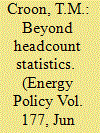

|
|
|
|
|
| Summary/Abstract |
Recent energy price spikes have led to increased energy poverty among low-income households living in inefficient homes. Accurate statistics on energy poverty help inform resource allocation and better target relief schemes and retrofit funds. Existing indicators are predominantly defined in terms of a headcount ratio – the share of population living below a certain threshold or poverty line. In this paper we draw from the literature on income poverty evaluation to argue that the use of more elaborate energy poverty gap indices can substantiate the design and monitoring of energy poverty policies, by not only considering incidence but also intensity and inequality of energy poverty across households. We demonstrate that the choice for a particular energy poverty (gap) indicator makes the implicit welfare choices of energy poverty policies explicit. We illustrate our arguments for the case of the Netherlands, using recently developed microdata statistics on energy poverty, and an imposed energy price shock. We show that spatial targeting of relief funds based on incidence would neglect the full depth of energy poverty deprivation. Finally, we argue that visualisation techniques from the income poverty literature help to comprehend different poverty orderings and draw comparisons between time periods, regions, and subgroups.
|
|
|
|
|
|
|
|
|
|
|
|
|
|
|
|
| 3 |
ID:
111402


|
|
|
|
|
| Publication |
2012.
|
| Summary/Abstract |
In the UK, the introduction of micro-generation Feed in Tariffs (FiTs) and a proposed Renewable Heat Incentive (RHI) for domestic and small scale schemes have re-energised the market for investment in domestic scale renewable energy. These incentives may provide financial opportunities for those with capital to spend but for the record numbers with low incomes in 'fuel poverty', these benefits may seem out of reach. This paper shows that with appropriate financial intermediaries it is possible for renewable energy incentives to be used to alleviate fuel poverty.
Simple financial analysis demonstrates the theoretical potential of FiTs to help those in fuel poverty. Two case studies of renewable energy projects in low income areas investigate how the incentives may be used in practice, what barriers exist and what success factors are evident. The analysis shows that local energy organisations (LEOs) are key if the poor are to access benefits from premium tariff schemes. Low interest finance mechanisms, good information sharing and community involvement are found as key success factors.
|
|
|
|
|
|
|
|
|
|
|
|
|
|
|
|
| 4 |
ID:
115635


|
|
|
|
|
| Publication |
2012.
|
| Summary/Abstract |
Energy efficiency and social programmes have failed to stem the dramatic increase in the number of fuel poor households in recent years. As the 2016 deadline for eradicating fuel poverty nears, energy efficiency and fuel poverty programmes are undergoing significant changes. The ambitions for Britain's Green Deal, the overhaul of supplier obligations alongside the winding down of Warm Front, and the introduction of an incentive for renewable heat combine to form a sea change in how energy efficiency and fuel poverty objectives are financed and delivered. Green Deal Finance (GDF) eliminates the up-front capital cost of energy efficiency measures to the household by linking repayments to energy savings and spreading them over many years. This paper asks whether and how GDF could be beneficial to fuel poor households. Using scenarios modelled on the English House Condition Survey, it explores the extent to which fuel poverty could be reduced, allowing for repayments incurred by GDF. It examines how much further fuel poverty could be alleviated were the capital cost subsidised or repayments supported, and concludes that a flexible design for GDF is necessary if it is to contribute to alleviating fuel poverty.
|
|
|
|
|
|
|
|
|
|
|
|
|
|
|
|
| 5 |
ID:
115624


|
|
|
|
|
| Publication |
2012.
|
| Summary/Abstract |
Fuel poverty has been most commonly researched in the UK although it is experienced in other parts of Europe, to varying degrees. Boardman (1991) showed that energy inefficient buildings and heating systems are the most significant components of fuel poverty and highlighted the legacy of older buildings in this country that remain the majority of those now recognised as hard to treat. This paper considers the historical context for fuel poverty as a particularly British phenomenon. It examines claims that this is due to the mild climate and low indoor temperature expectations. It is concluded that there are significant differences from the European situation. The climate, particularly its characteristic changeability, has influenced building and heating methods, and the low priority given to energy efficiency by legislators. Significantly, economic priorities produced poor quality mass housing during the industrial revolution. The availability of coal encouraged the use of open fires, which demanded high ventilation rates. The British do value warmth but older buildings designed for heating with radiant open fires are difficult to adapt to convective central heating. Lessons can be drawn for newly industrialised economies similarly producing poor quality mass housing with low priorities for energy efficiency.
|
|
|
|
|
|
|
|
|
|
|
|
|
|
|
|
| 6 |
ID:
162946
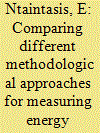

|
|
|
|
|
| Summary/Abstract |
This paper uses and comparatively evaluates objective, subjective and composite indicators for measuring and analyzing energy poverty in Attika Region, Greece. The necessary data for the quantification of these indicators were gathered through a survey involving 451 households. The results of the analysis showed that the measurement of energy poverty based on classical objective and subjective indices leads to divergent results, which in addition have little relevance to each other. To a large extent, households characterized as energy poor by one method are not classified as such with another. The use of composite indicators adjusted to local circumstances seems to form a more coherent framework for measuring energy poverty in an area and may provide additional information as regards the intensity of energy poverty. The implementation of the two composite indicators developed in the context of this study showed that energy poverty levels in the region of Attica range between 37% and 43.5%. About 27.5% of the households are energy poor with both composite indicators, while the 11.5% of households are characterized by high energy poverty intensity. Also, the analysis of the characteristics of the energy poor households provides useful insights for developing appropriate policies to tackle the problem.
|
|
|
|
|
|
|
|
|
|
|
|
|
|
|
|
| 7 |
ID:
150914


|
|
|
|
|
| Summary/Abstract |
In this article we conceptualise energy use from a capabilities perspective, informed by the work of Amartya Sen, Martha Nussbaum and others following them. Building on this, we suggest a corresponding definition of energy poverty, as understood in the capabilities space. We argue that such an understanding provides a theoretically coherent means of comprehending the relationship between energy and wellbeing, and thus conceptualising energy deprivation, that makes sense across settings including both the global North and South: a coherence which has previously been lacking. At the same time, it has the flexibility to be deployed in a way that is sensitive to local contexts. Understanding energy use in the capabilities space also provides a means for identifying multiple sites of intervention, including some areas that are currently largely overlooked. We argue that this is advantageous for attempts to address energy poverty in the context of climate change and imperatives for the containment of aggregate energy consumption.
|
|
|
|
|
|
|
|
|
|
|
|
|
|
|
|
| 8 |
ID:
176746
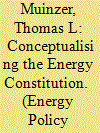

|
|
|
|
|
| Summary/Abstract |
In order to elucidate key aspects of the relationship between energy and constitutionality, Muinzer and Ellis (2017) have mapped the full spectrum of UK reserved/devolved constitutional powers and thrown into relief the complex form and nature of low carbon energy powers within that nexus. This low carbon-specific framework, and an understanding of its complex, contingent qualities and interconnected constitutional principles provides insight into the extent to which constitutional arrangements reify the territoriality of energy governance and policy capacity, structuring the policy and governance relationships between national and substate multi-level decarbonisation processes. This study develops this ‘Energy Constitution’ framework with reference to fuel poverty, honing in on the UK and according particular attention to Northern Ireland, a UK jurisdiction that often receives little attention in energy policy studies, but that has had notably high levels of fuel poverty, in addition to the weakest substate economy and the most energy insecure circumstances in the UK.
|
|
|
|
|
|
|
|
|
|
|
|
|
|
|
|
| 9 |
ID:
115629
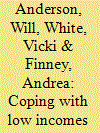

|
|
|
|
|
| Publication |
2012.
|
| Summary/Abstract |
This paper presents findings from a study of low-income households in Great Britain which explored households' strategies for coping both with limited financial resources in the winter months, when demand for domestic energy increases, and, in some cases, with cold homes. The study combined a national survey of 699 households with an income below 60 per cent of national median income with in-depth interviews with a subsample of 50 households. The primary strategy adopted by low-income households to cope with financial constraint was to reduce spending, including spending on essentials such as food and fuel, and thereby keep up with core financial commitments. While spending on food was usually reduced by cutting the range and quality of food purchased, spending on energy was usually reduced by cutting consumption. Sixty-three per cent of low-income households had cut their energy consumption in the previous winter and 47 per cent had experienced cold homes. Improvements to the thermal performance of homes reduced but did not eliminate the risk of going cold as any heating cost could be a burden to households on the lowest incomes. Householders' attitudes were central to their coping strategies, with most expressing a determination to 'get by' come what may.
|
|
|
|
|
|
|
|
|
|
|
|
|
|
|
|
| 10 |
ID:
115626
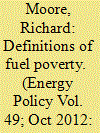

|
|
|
|
|
| Publication |
2012.
|
| Summary/Abstract |
This paper outlines why the definition of fuel poverty is important in policy formulation and describes how the Government's current definitions evolved from the original concept. It discusses the determination of income and fuel costs and the possibilities for a relative and common European measure. It examines problems inherent in assessing fuel costs as a percentage of income and puts forward the arguments for a 'budget standard' approach. The paper illustrates how the size of the problem depends on the definition and chosen threshold and suggests advantages for a rating scale. It illustrates how the income composition and thresholds also govern the distribution of the target populations and the relative importance of the main causal factors, and examines the consequent policy implications. It explores the definition of vulnerable households and the importance of severity and questions whether the UK fuel poverty strategy is targeted at households least able to afford their fuel costs (as the name implies) or primarily those at risk from excess winter and summer mortality and morbidity. Finally, after examining the role of supplementary indicators, it looks at the opportunities for changing the definition and comments on the Government review of the definition and targets.
|
|
|
|
|
|
|
|
|
|
|
|
|
|
|
|
| 11 |
ID:
162902
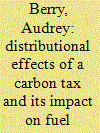

|
|
|
|
|
| Summary/Abstract |
This paper studies the distributional effects of France's recently introduced carbon tax. Using a microsimulation model built on a representative sample of the French population from 2012, it simulates the taxes levied on each household's consumption of energy for housing and transport. Without revenue recycling, the carbon tax is regressive and increases fuel poverty. From a policy perspective, this finding indicates that the question of fuel poverty cannot be ignored in the quest for a fair ecological transition. It proposes that some of the revenues from the carbon tax should be redistributed to households. Different designs of cash transfer to support households are then compared. The results show that the inequities of the carbon tax could be offset at reasonable cost relative to total carbon tax revenues. However, adjusting the design of cash transfers to criteria other than income level does not diminish the cost of compensating households. The benefits of finely adjusting cash transfers may therefore be somewhat limited. Most notably, the results show that targeting revenue recycling at low-income households would help to reduce fuel poverty substantially. This study therefore indicates that carbon taxation actually provides an opportunity to finance ambitious policies to fight fuel poverty.
|
|
|
|
|
|
|
|
|
|
|
|
|
|
|
|
| 12 |
ID:
117243


|
|
|
|
|
| Publication |
2013.
|
| Summary/Abstract |
Prepayment metering is an electricity payment method often used by low-income consumers. Fuel poverty is an important public health problem in New Zealand, and is likely to be a particular problem for those using prepayment metering. This paper details a nationwide postal survey of consumers undertaken with the support of three major electricity retailers, which investigated the advantages and disadvantages of using prepayment metering from a consumer perspective. The study surveyed a total pool of 359 randomly selected consumers across the three companies, a response rate of 48%. The study found that while almost all respondents felt the benefits of using prepayment outweighed the risks of running out of credit or 'self-disconnection', 53% of respondents experienced self-disconnection in the past year. Of concern, over a third of respondents experiencing self-disconnection were without electricity for more than 12 h. The frequency of self-disconnection was also high, with 17% of those disconnecting reporting six or more events in the past year. Government intervention could reduce the risks and disadvantages involved with using prepayment metering, which could then support initiatives aimed at reducing fuel poverty.
|
|
|
|
|
|
|
|
|
|
|
|
|
|
|
|
| 13 |
ID:
136239


|
|
|
|
|
| Summary/Abstract |
In this paper, we discuss a number of ways to define and measure the affordability of energy consumption, and we examine the emergence of energy poverty in Italy in the period from 1998 to 2011. The paper examines the eligibility criteria for claiming the benefits available to support energy consumption for vulnerable families and it identifies the potential beneficiaries. The study assesses the appropriateness of the eligibility criteria by comparing the population targeted by the policy with the population actually facing affordability problems. A simulation exercise, using the hypothetical scenario most likely to result in energy benefits being made available, shows that, regardless of the affordability index adopted, the provision of state energy benefits has little impact on fuel poverty.
|
|
|
|
|
|
|
|
|
|
|
|
|
|
|
|
| 14 |
ID:
133228
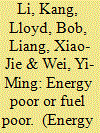

|
|
|
|
|
| Publication |
2014.
|
| Summary/Abstract |
Energy poverty and fuel poverty are descriptors of problems of households' energy consumption, they are both distinct problems and have been addressed by many researchers, organizations and governments. Cross use of the terms of energy poverty and fuel poverty in published papers is common. As an accurate descriptor is the presupposition of research and policy development, especially for those who just started to pay attention to this issue, this paper compares the definitions, research priorities, status quo, and problems of these two concepts, and summarizes the relationship between them. The paper suggests that only when the research targets are households who are living in a cold climate and have difficulty in getting access to electricity or modern cooking facilities, and in supplying indoor heating with appropriate cost, the concepts of energy poverty and fuel poverty have the chance to be broadened and mutually integrated.
|
|
|
|
|
|
|
|
|
|
|
|
|
|
|
|
| 15 |
ID:
177383
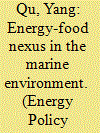

|
|
|
|
|
| Summary/Abstract |
The rapid development of offshore wind farms (OWFs) has stimulated debate about its overall socioeconomic impacts. Expanding the scale of OWFs increases the availability and affordability of electricity but could displace existing fishing activities and reduce food supply. To evaluate these impacts from a macroeconomic perspective, a computable general equilibrium (CGE) model is developed, using Scotland as a case study. A particular focus is placed on the disaggregated electricity and seafood sectors, their interconnectedness from an energy-food nexus perspective, and the distributional effects across household groups. This paper explores, from macroeconomic perspective, the trade-offs in the energy-food nexus between expanding OWFs and the seafood sectors, together with the impacts on food and energy security. The results suggest that, through economic linkages, increasing the number of OWFs would have a negative, but limited, effect on seafood production sectors. However, the falling cost of electricity from OWFs would have a positive impact on the economy overall and benefit lower income households, contributing to a reduction in fuel poverty. The model results raise the awareness of nexus linkages between OWFs and seafood production and are applicable to policies involving the development of other offshore renewables.
|
|
|
|
|
|
|
|
|
|
|
|
|
|
|
|
| 16 |
ID:
126558


|
|
|
|
|
| Publication |
2013.
|
| Summary/Abstract |
Recent audits have shown that anti-fuel poverty policies in the UK depend on loosely defined targeting and cannot accurately identify fuel poor households. New methods of targeting are necessary to improve fuel poverty policy. This paper uses Geographic Information System (GIS) techniques to evaluate the targeting of a home energy efficiency scheme small area level in Northern Ireland, based on the level of need. The concept of need is modelled using an area-based, multi-dimensional fuel poverty risk index. The characteristics and spatial distribution of household retrofits are explored. Policy activity and expenditure are compared with the level of need in an area. Results indicate that policy activity is only weakly associated with the level of need in an area, although policy appears to be well targeted in a few areas. Contrary to existing evidence, rural areas appear to be well served by policy, receiving above average numbers of retrofits and expenditure. There are typically two types of retrofit (major and minor). Most retrofits are minor and may not reduce fuel poverty. These results evidence the limitations of the current targeting system and suggest that there may be scope for improved policy implemented via a more proactive, area-based approach.
|
|
|
|
|
|
|
|
|
|
|
|
|
|
|
|
| 17 |
ID:
168322


|
|
|
|
|
| Summary/Abstract |
Energy poverty is defined as the inability to afford to heat the home to an adequate temperature at reasonable cost. Such a concept has gained political recognition in an increasing number of countries; however, in the United Kingdom, related policies tend to rely upon measures of general deprivation as a practical proxy. This has often resulted in the design of sub-optimal schemes for eradicating this issue.
|
|
|
|
|
|
|
|
|
|
|
|
|
|
|
|
| 18 |
ID:
115630


|
|
|
|
|
| Publication |
2012.
|
| Summary/Abstract |
Until the present day, research on fuel poverty focussing on the point of view of those concerned is few and far between. The present paper aims at filling this gap, analysing experiences with and behavioural responses to fuel poverty. It examines the day-to-day energy situation of households, which are poor/at-risk-of-poverty and/or suffering from fuel poverty in a case study conducted in the Austrian capital Vienna. Qualitative interviews provide the data for investigating the relevant factors in causing fuel poverty (among those, bad housing conditions, outdated appliances, financial problems), and provide a basis for discussion about the respective behavioural strategies of the people concerned. The results show that the ways of handling this problematic situation vary greatly and that people follow different strategies when it comes to inventing solutions for coping with the restrictions and finding ways of satisfying at least a part of their basic energy needs. Nonetheless, it also clearly surfaces that the scope of action is limited in many cases, which in turn only supports the claim that changes in the overall conditions are essential.
|
|
|
|
|
|
|
|
|
|
|
|
|
|
|
|
| 19 |
ID:
150879


|
|
|
|
|
| Summary/Abstract |
Fuel poverty and cold housing constitute a significant public health problem. Energy efficiency interventions, such as façade retrofitting, address the problem from a structural and long-term perspective. Despite evidence of the health benefits of insulation, little is known about the political and social contexts that contribute to social inequalities in receiving and experiencing health benefits from these interventions. We used a realist review methodology to better understand the mechanisms that explain how and why variations across different social groups appear in receiving energy efficiency façade retrofitting interventions and in their impact on health determinants. We considered the four stages of the policy implementation framework: public policy approach; policy; receiving intervention and impact on health determinants. We found strong evidence that certain social groups (low-income, renters, elderly) suffering most from fuel poverty, experience more barriers for undertaking a building retrofitting (due to factors such as upfront costs, “presentism” thinking, split incentives, disruption and lack of control), and that some public policies on housing energy efficiency may exacerbate these inequalities. This can be avoided if such policies specifically aim at tackling fuel poverty or social inequities, are completely free to users, target the most affected groups and are adapted to their needs.
|
|
|
|
|
|
|
|
|
|
|
|
|
|
|
|
| 20 |
ID:
115637
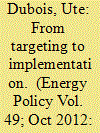

|
|
|
|
|
| Publication |
2012.
|
| Summary/Abstract |
This paper proposes to evaluate the efficiency of fuel poverty policies by looking at them as a three-step process. These steps are policy targeting, identification of households and implementation of measures. Each of these steps are costly and can face feasibility problems. This is particularly true in the case of fuel poverty policies, because of the multidimensional aspect of fuel poverty. Therefore, public policies in that field are necessarily imperfect, and this should be taken into account in the analysis of policies. This three-step framework is applied to the French fuel poverty policy, which has been developed in 2010. As its practical modalities of implementation are still under discussion, we mainly discuss the choices made in terms of targeting and highlight the role of identification of fuel poor households as a key factor for the success of that policy. The general idea behind this discussion is that the efficiency of such policies has to be viewed in a comprehensive way, which includes the three policy steps.
|
|
|
|
|
|
|
|
|
|
|
|
|
|
|
|
|
|
|
|
|